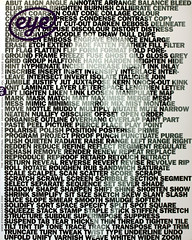Summer 2003
Fetish and fantasy
Letter from Quentin Newark
In his review of Rewind (Eye no. 47, vol. 12), Rick Poynor argues that Rewind is poor history, because the D&AD competition, and therefore the annual, was bypassed by designers ‘who really did have influence overseas in their day’, and names a handful of designers not in the book.
Surely this is a strange criticism to make, relying as it does on two very questionable assumptions. Firstly, he seems to assume that any method of recording (book, competition or magazine) can be complete. Isn’t it more a question of understanding and accepting how each method is incomplete? Secondly, he assumes that we all agree on his assessment of the ‘influence overseas’ exerted by his chosen examples, as though there were incontrovertible evidence that this really existed. Doesn’t this rather depend on how we measure ‘influence’?
Is ‘influence’ column inches? Or momentary notoriety? Or awards accumulated over years? Or the way a designer’s work affects other designers? If we use this last as a measure, some of the highly influential designers acknowledged in Rewind’s pages appear nowhere in Eye’s pages. Michael Rand, Jon Gorham, Mary Lewis, David Stuart and Aziz Cami, John McConnell and Michael Wolff have never enjoyed Eye’s attention. These are designers whose influence in the past and in the present, (in the words of a recent Eye editorial) is ‘so great that it is almost invisible’. Invisible to Eye, which I would guess purports to be good history.
Poynor also bemoans D&AD’s judging as ‘biased by hidden factors’, and therefore crippled. I am no apologist for the D&AD competition, but can’t this point ultimately be made of any judgement? Isn’t all judgement of design about employing values, and aren’t these always informed by hidden factors: i.e. our deeply held prejudices and beliefs? I find much of the journalism in Eye strongly coloured by barely disguised ‘factors’ – a loathing of commerce; fetishisation of the idea of the avant-garde; fantasies about radical politics. Do these ‘factors’ behind a good many of the pieces in Eye make it inadequate?
I think Poynor’s problem with D&AD is that there is no single presiding intelligence. It is unpredictable. The competition suffers from the randomness and twists and turns of a certain kind of communal effort. D&AD is an enormously influential annual collection (and now a history book and an exhibition) compiled, graded, admired and criticised by designers themselves.
What is wrong with designers making a record of design, with certain of Poynor’s favourites excluded?
London
First published in Eye no. 48 vol. 12 2003
Eye is the world’s most beautiful and collectable graphic design journal, published for professional designers, students and anyone interested in critical, informed writing about graphic design and visual culture. It is available from all good design bookshops and online at the Eye shop, where you can buy subscriptions, back issues and single copies of the latest issue. You can also browse visual samples of recent issues at Eye before You Buy.

